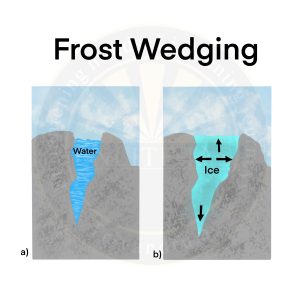Weathering
- What is it?: Weathering denotes the process of wearing, breaking up, and fragmentation of the rock that creates the surface of the ground and remains exposed to the weather. It is an In Situ disintegration or breakdown of rock material.
- Three types are
- Mechanical Weathering
- What is it?: Physical weathering involves the mechanical disintegration of rocks due to temperature changes, freeze-thaw cycles, wet-dry cycles, crystallization of salts, animal and plant activity, etc.
- Different mechanism is
- Exfoliation due to pressure release or unloading
- Intrusive igneous rocks formed deep beneath the Earth’s surface are under tremendous pressure due to overlying load.
- Removal of the overlying load because of continued erosion causes vertical pressure release This results in the expansion of the upper layers of the rock creating fractures parallel to the surface.
- Over time, sheets of rock break away from the exposed rocks along the fractures in a process known as exfoliation.
- Exfoliation due to pressure release is also known as “sheeting“.
- Exfoliation due to thermal stress weathering
- Thermal stress weathering results from the subsequent expansion and contraction of rocks caused by diurnal and seasonal variations in temperatures.
- The surface layers of the rocks tend to expand more than the rock at depth, and this leads to peeling off of the surface layers (exfoliation).
- This process is most effective in dry climates and high elevations where diurnal temperature changes are drastic.
- Granular Disintegration
- Granular disintegration happens in rocks composed of different types of coarse-grained minerals.
- Dark-colored minerals absorb more heat than light-colored minerals.
- This leads to differential expansion and contraction of mineral grains resulting in grain-by-grain separation from the rock.
- Salt Weathering
- Salt weathering occurs when saline solutions seep into cracks and joints in the rocks and evaporate, leaving salt crystals behind.
- Salt crystals expand during the crystallization process and also when they are subjected to above-normal temperatures.
- The expansion in near-surface pores causes the splitting of individual grains within rocks, which eventually fall off.
- Frost Wedging
- Freeze wedging is caused by the repeated freeze-thaw cycle.
- Cracks filled with water are forced further apart with subsequent freezing and thawing.
- Exfoliation due to pressure release or unloading
- Mechanical Weathering

-
- Chemical Weathering
- Chemical weathering involves the chemical decomposition of rocks and soil.
- Chemical weathering processes include dissolution, solution, carbonation, hydration, oxidation, and reduction which act on the rocks to decompose, dissolve, or reduce them to a fine state.
- Different types
- Hydrolysis and oxidation
- Hydrolysis – It is due to the dissociation of H2O into H+ and OH- ions which chemically combine with minerals and bring about changes, such as exchange, decomposition of crystalline structure, and formation of new compounds.
- Oxidation – Oxidation is the reaction of a substance with Oxygen.
- Hydrolysis and oxidation
- Biological Weathering
- Biological weathering is the weakening and subsequent disintegration of rock by plants, animals, and microbes.
- It can occur due to physical stress like in the case of penetration of plant roots and burrowing of animals.
- Chemical Weathering
Erosion
- Erosion is the act in which the earth is worn away, often by water, wind, or ice.
- It is an ex-situ process where an external agent is involved.
Deposition
- The deposition is a consequence of erosion. The erosional agents lose their velocity and energy on gentle slopes and materials carried by them start to settle themselves.
- Deposition is not the work of any agents. It is just the result of erosion.
